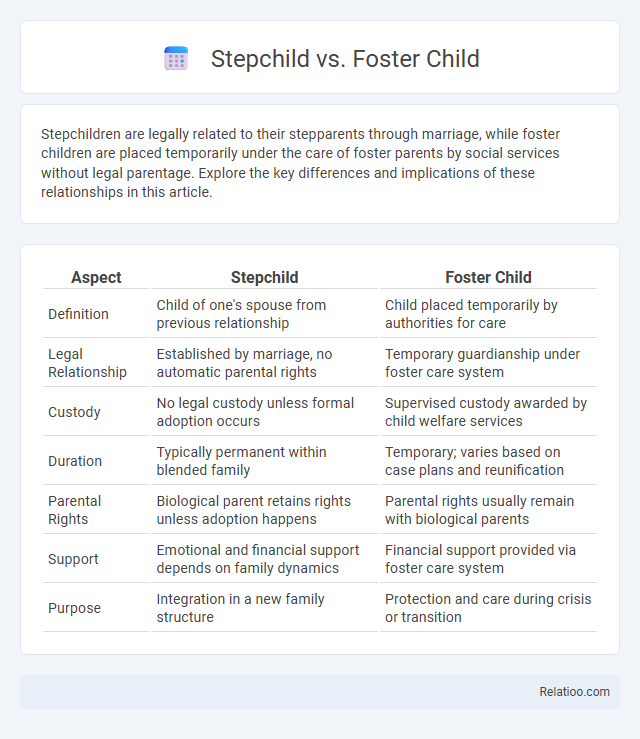Stepchildren are legally related to their stepparents through marriage, while foster children are placed temporarily under the care of foster parents by social services without legal parentage. Explore the key differences and implications of these relationships in this article.
Table of Comparison
| Aspect | Stepchild | Foster Child |
|---|---|---|
| Definition | Child of one's spouse from previous relationship | Child placed temporarily by authorities for care |
| Legal Relationship | Established by marriage, no automatic parental rights | Temporary guardianship under foster care system |
| Custody | No legal custody unless formal adoption occurs | Supervised custody awarded by child welfare services |
| Duration | Typically permanent within blended family | Temporary; varies based on case plans and reunification |
| Parental Rights | Biological parent retains rights unless adoption happens | Parental rights usually remain with biological parents |
| Support | Emotional and financial support depends on family dynamics | Financial support provided via foster care system |
| Purpose | Integration in a new family structure | Protection and care during crisis or transition |
Understanding the Definitions: Stepchild vs Foster Child
A stepchild is a child of one's spouse from a previous relationship, legally connected through marriage but not through biological or adoption ties. A foster child, by contrast, is a minor placed under the temporary care of a family by a public agency or court, often without permanent legal parental rights. Understanding these distinctions is crucial for legal, social, and caregiving contexts, impacting custody, inheritance, and welfare responsibilities.
Legal Status and Parental Rights
Stepchildren typically have legal recognition through marriage, granting stepparents limited parental rights unless formal adoption occurs, whereas foster children remain under state custody with foster parents holding temporary guardianship without permanent parental rights. Legal status of stepchildren depends on jurisdiction and whether stepparents pursue legal adoption to obtain full parental rights, while foster care involves court supervision and compliance with child welfare regulations. Parental rights for stepparents may be established via adoption petitions, while foster parents must follow state-mandated guidelines with no transfer of parental rights unless adoption is finalized.
Pathways to Family Integration
Pathways to family integration differ significantly among stepchildren, foster children, and adopted children. Stepchildren become part of your family legally through marriage, without altering parental rights, fostering emotional bonds rather than formal adoption. Foster children experience temporary placement aimed at reunification or adoption, while adopted children achieve permanent family integration through legal adoption, granting full parental rights and responsibilities.
Emotional and Social Dynamics
Stepchildren often experience complex emotional dynamics as they navigate loyalty to biological parents and forming bonds with stepparents, which can affect their social relationships and sense of belonging. Foster children may face greater challenges, including feelings of instability and trauma, impacting emotional regulation and trust in social environments. Your awareness of these differences helps support healthier emotional and social development tailored to each child's unique family context.
Financial Responsibilities and Support
Financial responsibilities for a stepchild typically depend on legal adoption or court orders, while foster parents receive state funding but have limited long-term financial obligations. You may be required to provide full financial support for your stepchild only if you legally adopt them or if specific custody arrangements are made. In contrast, foster care involves state or agency support to cover the child's needs, with foster parents primarily providing day-to-day care rather than long-term financial support.
Role of Biological Parents
The role of biological parents differs significantly among stepchild, foster child, and adopted child relationships. In the case of a stepchild, the biological parents typically maintain legal parental rights and responsibilities, even though the stepparent may take on a parental role. For foster children, biological parents often retain legal rights unless those rights are terminated, while foster parents provide care temporarily under state supervision; adopted children have their biological parents' rights permanently transferred to the adoptive parents, legally severing the biological connection. Understanding these distinctions is crucial for managing Your parental responsibilities and navigating legal frameworks effectively.
Adoption Possibilities and Differences
Stepchildren are the biological children of your spouse, and adoption allows you to legally establish parental rights, providing full inheritance and custody benefits. Foster children live temporarily in your care through a state or agency placement, with adoption options depending on the child's legal status and willingness of biological parents to relinquish rights. Understanding these distinctions helps you navigate adoption processes, ensuring the best legal and emotional outcomes for each child type.
Inheritance and Succession Concerns
Inheritance laws differ significantly between stepchildren, foster children, and biological children, often impacting succession planning. Stepchildren generally do not have automatic inheritance rights unless legally adopted, while foster children typically lack inheritance claims unless designated in a will. You should ensure clear legal documentation to protect your intentions regarding succession and inheritance for all involved parties.
Challenges Faced by Stepchildren and Foster Children
Stepchildren often face challenges related to adjusting to new family dynamics, loyalty conflicts, and acceptance by stepparents and stepsiblings, impacting their emotional well-being. Foster children experience instability from frequent placements, trauma due to past neglect or abuse, and difficulties forming lasting attachments, which can affect their development and sense of security. Understanding your child's unique background and providing consistent support helps address these distinct emotional and psychological challenges effectively.
Support Systems and Resources Available
Support systems for stepchildren primarily involve blended family counseling and legal resources addressing parental rights, while foster children have access to government-funded programs, including social services, healthcare, and educational support through child welfare agencies. Stepchildren typically rely on family-based resources and private counseling services, whereas foster children benefit from structured support systems designed to ensure their safety, stability, and development. Understanding these distinctions helps you navigate the appropriate resources tailored to each child's unique needs.

Infographic: Stepchild vs Foster Child
 relatioo.com
relatioo.com